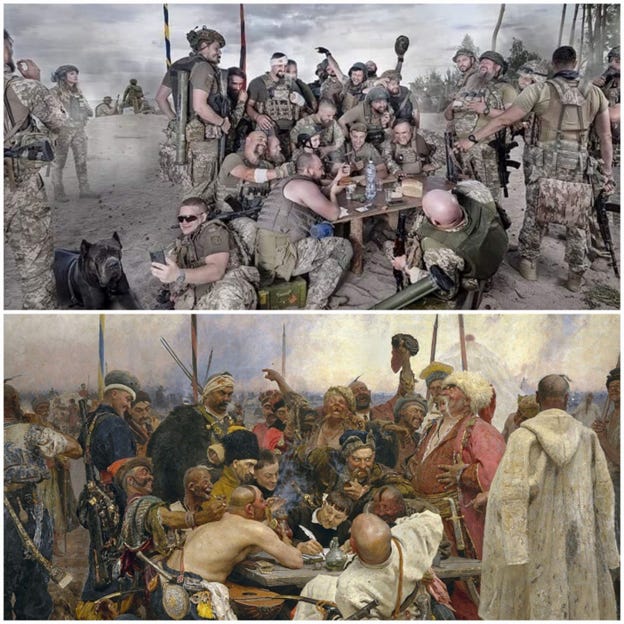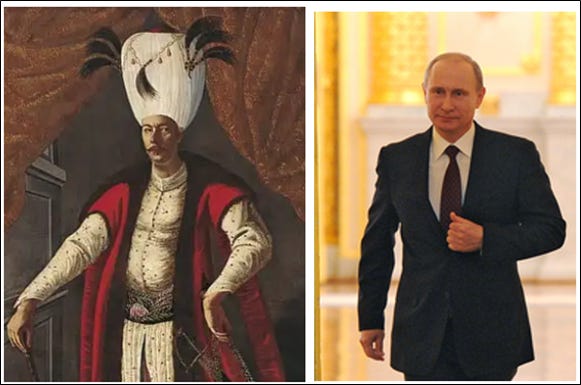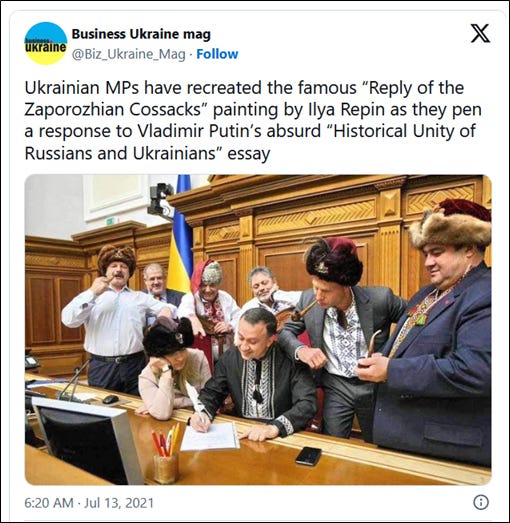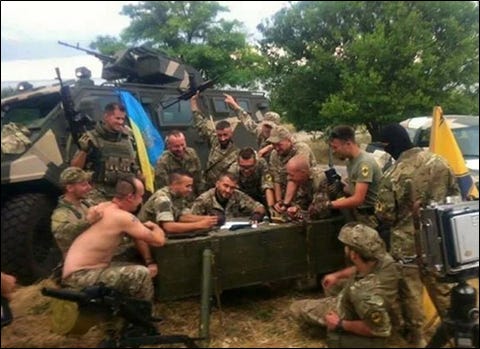Nailed It! Ukrainians Re-Enact Mocking Cossack Reply To Despot
“By land and by sea we will battle with thee. F*** thy mother!” Roots of democracy pre-date Russia and explain today’s Ukrainian threat to Putin.
Ukrainian soldiers have recreated a famous painting called “Reply of the Zaporozhian Cossacks”, in which their ancestors sent an insulting letter to an Ottoman despot. The heritage behind the insult reveals the difference between Ukraine and Russia today, where Russians themselves are very unhappy with Putin’s war but are unable to express it.
The painting is of an historical scene in 1676 where Cossacks allegedly sent an insulting reply to an ultimatum from the Sultan of the Ottoman Empire, Mehmed IV. The canvas is 2 by 3.6 meters, or more than seven square meters of insult. Majestic.
The Zaporozhian Cossacks (from “beyond the rapids”), lived around the lower Dnieper River in Ukraine. They had just defeated Ottoman Empire forces in battle. However, despite his army having suffered this loss to them, Mehmed demanded that the Cossacks submit to Ottoman rule. The Cossacks, led by Ivan Sirko, replied in a characteristic manner: they wrote a letter, replete with insults and profanities (words below).
The painting shows the Cossacks joyously coming up with ever-worse profanities to put in the letter.
Its spiritual thread can be seen today in the defiance shown by the Ukrainian defenders of Snake Island to the surrender demand from the Moskva cruiser: “Russian warship, go fuck yourself.”
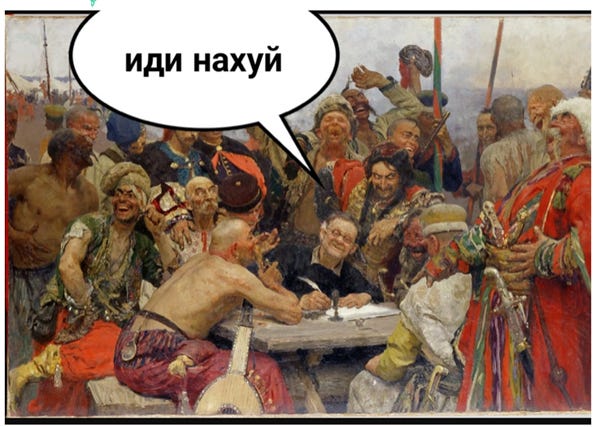
Can’t say it more concisely than that!
The Moskva was later incapacitated by a Ukrainian sea drone. Maybe curses do have power.
The historical Zaporozhian Cossacks were known for their contemptuous disregard for authority — a characteristic very different from the inhabitants of the Rus area that evolved into Russia. At that time a terrible famine had swept the Rus, and the Russian peasants appealed to their lords for sustenance. They paid with whatever freedom they had left: a new law bound them to remain within their lord’s domain. They were thus cut off from the key alternative that other cultures throughout history used to create democracies: they had no option to just move away and settle somewhere else. This is what made America the first modern democracy: its inhabitants could just wander off into the endless forests and set up a cabin beyond the reach of any landlord.
The Huron Indians had the same recourse and were a similar early democracy, as were many African tribes. Democracy goes way back, and has sustained itself over thousands of years. It is the first form of governance of an early society, in fact: we all started with rule-by-assent, or early democracy.
The Cossacks themselves were ethnically and religiously open to anybody, and were one of many cultures that merged to form modern Ukraine. Unlike Russia, Ukraine today still has a tolerance for differing views and different ethnicities. Their ancestors came from Ukrainian, Russian, Polish, and Tatar territories, and migrated at great risk to the southern steppes to hunt and fish. The Cossacks were particularly noted for holding democratic traditions.
It was the Cossacks who spread and popularized the term “Ukraine”, which had not been used in the pre-Cossack era, as the name of their territories.
Zaporozhian Cossacks were the first purely Ukrainian society. As a nascent nation, it fought for the right to exist, develop, and resist hostile encroachments. The Cossack army created its own, uniquely developed state-administrative structure, which fundamentally different from similar structures of neighboring states. They received foreign ambassadors and concluded international agreements.
The geography lent itself to freedom. The people of Crimea had been trading with Europe for a thousand years before the Cossacks arrived, and had their own traditions of freedom. The open steppes promoted the development of land freedom and self-governance.
Even the figures in the painting included men of Ukrainian, Russian, Cossack, Jewish and Polish ancestry. They were friends of the painter Ilya Repin and are depicted well in this article.
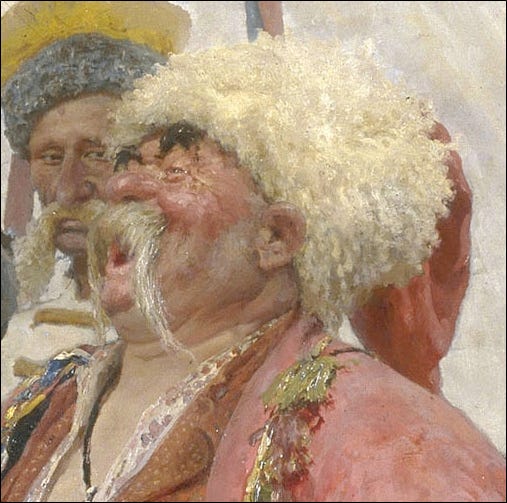
The Ukrainian soldiers who are recreating the painting are of course snubbing their nose at a different tyrant — not an Ottoman Sultan but a Russian Tsar-Imitator. There is no doubt that the folks represented in the original painting would nod approvingly at the sentiments in the new photo.
As, indeed, might the Russians themselves.
Elena Koneva, a researcher at Russia’s opinion-polling company ExtremeScan, in May cited polls showing a 50/50 split between Russians backing the war and those against it.
This was corroborated by research done by the Open Minds Insitute (OMI), a hub focused on disinformation and propaganda. It found in a recent poll that around 80% of Russians were worried about their financial well-being. This figure was a noticeable 30-point jump since the question was last asked in May.
OMI founder and CEO Sviatoslav Hnizdovskyi said the rise might indicate “a trend where refrigerator reality beats TV propaganda, potentially leading to increased dissatisfaction among the Russian population if it continues. Handling an angry and hungry crowd could be tougher than dealing with a small group of protesters who oppose the government’s actions on moral grounds,” he wrote, “just as it was in [the Russian Revolution of] 1917, when lack of bread and other food shortages, combined with failures at the frontlines, played one of the critical roles in social unrest.”
Only half of those surveyed by OMI believed that the average citizen has all the means to live a good life in Russia.
Russia spends billions each year on propaganda to counter any bad news, fiercely repressing anti-war dissent.
Nevertheless, as many as 16% of those surveyed by OMI wanted to move out of Russia. Some 900,000 Russians are estimated to have left the country since the invasion began. Among those who remained, the survey identified “bursts of anxiety” that have started emerging among what it described as “Loyalists” — those who generally agree with the objectives of government, but can question its means.
Critics of the “special operation”, as it is known inside the country, have been subjected to hefty fines, arrests and outright violence, with one Russian father detained for his daughter’s supposed anti-war drawings at school.
Cossack autonomy was liquidated by Empress Catherine and finished off by the Bolsheviks. The threat of freedom posed by the Cossacks to the tsars and commissaires was extinguished. The Rus themselves had no culture of self-rule and no representative council tradition. Russia has been a dictatorship-in-embryo from the beginning.
This is one of the reasons that today’s Ukraine recognizes the history of the Zaporozhian Cossacks as an integral part of its own history and one of the most important sources of national identity. A direct reference to the Cossack tradition can even be found in the anthem of Ukraine.
The vitality of the Reply painting has inspired many Ukrainians to use its theme to jab Putin:
Here is an early version of the military reply, probably taken in 2015 just as the Russians were getting underway with their invasions.
BTW, here is their original reply to the Sultan:
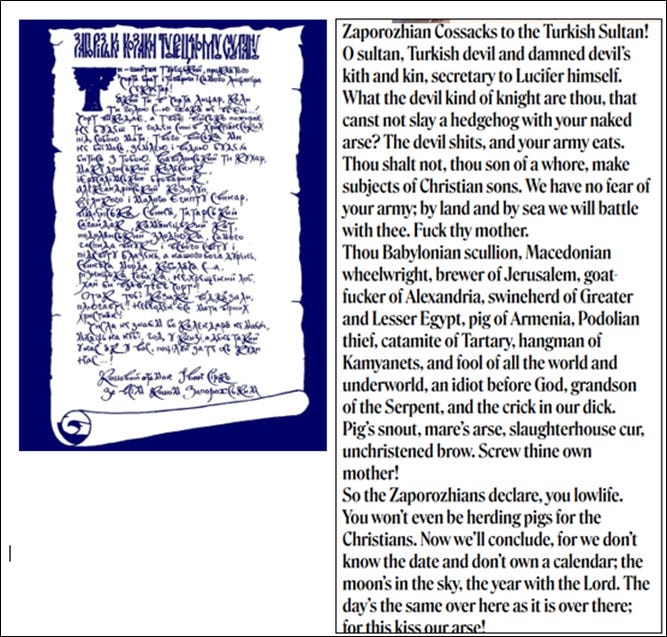
Clear, concise and powerful. Can’t ask better than that in a diplomatic message!
At the time the Ottomans were selling Balkan Christians into slavery. The letter is strong because feelings ran deep.
In the original Ukrainian version the message is even more powerful because it actually rhymes.
Ironically, the painting is now on display at the Russian State Museum in St. Petersburg.
More important, the painting — and all of its current Ukrainian-themed variations — are also on display on the Internet.
Where Putin can’t control the messaging.
As the Cossacks might say: “We have no fear of your army. By land and by sea we will battle with thee.”
And so they shall, and so they do.
Written by Barry Gander
A Canadian from Connecticut: 2 strikes against me! I'm a top writer, looking for the Meaning under the headlines. Follow me on Mastodon @Barry


